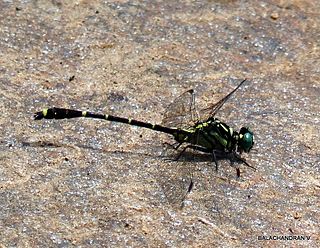
The Aeshnidae, also called aeshnids, hawkers, or darners, is a family of dragonflies, found nearly worldwide. The family includes some of the largest dragonflies.

The skimmers or perchers and their relatives form the Libellulidae, the largest dragonfly family in the world. It is sometimes considered to contain the Corduliidae as the subfamily Corduliinae and the Macromiidae as the subfamily Macromiinae. Even if these are excluded, there remains a family of over 1000 species. With nearly worldwide distribution, these are almost certainly the most often seen of all dragonflies.

Carpenter bees are species in the genus Xylocopa of the subfamily Xylocopinae. The genus includes some 500 bees in 31 subgenera. The common name "carpenter bee" derives from their nesting behavior; nearly all species burrow into hard plant material such as dead wood or bamboo. The main exceptions are species in the subgenus Proxylocopa, which dig nesting tunnels in suitable soil.

The Platycnemididae are a family of damselflies. They are known commonly as white-legged damselflies. There are over 400 species native to the Old World. The family is divided into several subfamilies.

Burmagomphus is a genus of dragonfly in the family Gomphidae. It contains the following species:

Gynacantha is a genus of dragonflies in the family Aeshnidae. The females have two prominent spines under the last abdominal segment. This gives the genus name and the common name two-spined darners; they are also known as duskhawkers.
Oligoaeschna is a genus of dragonfly in the family Aeshnidae. It contains the following species:

Prodasineura, the Asian threadtails, is a genus of damselflies in the family Platycnemididae. All the Afrotropical species formerly in this genus are now placed in Elattoneura, the African threadtails. Dijkstra et al. (2014) moved the genus from Protoneuridae to Platycnemididae based on molecular phylogenetic research.

Pseudagrion is the largest genus of damselfly in the family Coenagrionidae, with over 140 species. Its range includes most of Africa, much of Asia, and Australia. Africa holds most of the diversity with almost 100 species. It has occupied most of the freshwater habitats in its range, and dominates damselfly communities in habitats as different as desert pools, equatorial rainforests and montane streams.

Rhinocypha is a genus of damselflies in the family Chlorocyphidae.

Teinobasis is a genus of damselflies in the family Coenagrionidae. Species occur in south-eastern Asia, Indonesia, Solomon Islands and Micronesia; one species, Teinobasis rufithorax, is found in Australia.

Thyreus is an Old World genus of bees, one of many that are commonly known as cuckoo bees, or cloak-and-dagger bees, and are kleptoparasites of other species of bees, mostly in the genus Amegilla. They all have strongly contrasting patterns of coloration – three species from the Sydney region, Thyreus nitidulus, T. lugubris, and T. caeruleopunctatus are bright blue and black.

Nannophlebia is a genus of dragonfly in the family Libellulidae. They are commonly known as Archtails. The species are very small with black and yellow striped abdomens.
Agyrtacantha is a genus of dragonflies in the family Aeshnidae. Species of Agyrtacantha can be large, dull-coloured dragonflies.

Eusynthemis is a genus of dragonflies in the family Synthemistidae. They are commonly known as tigertails. Species of this genus are found mostly in Australia with one species, Eusynthemis frontalis, found in the Solomon Islands.
Palaeosynthemis is a genus of dragonflies. The genus includes these species:

Procordulia is a genus of dragonfly in the family Corduliidae. Procordulia are found in Southeast Asia, New Guinea, Australia, New Zealand and parts of the Pacific region.
Huonia is a genus of dragonfly in the family Libellulidae. Species of this genus are found in Indonesia, New Guinea and Australia.
Selysioneura is a genus of damselflies in the family Isostictidae. There are about 16 described species in Selysioneura.

Palaiargia ernstmayri is a species of broad-winged damselfly in the family Platycnemididae. The species is endemic to the Arfak Mountains of New Guinea, with only four observations to date.














